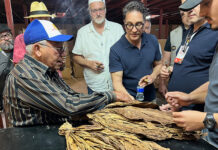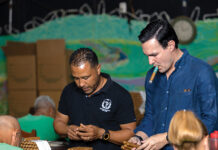There are a lot of cigars featured in this book. Did you smoke each of these cigars? How long did it take you to research and write this book? With all the Impossible Collection titles, there are precisely 100 curated examples of each book’s subject—thus 100 cigars. In the introduction, I make it transparently clear that while I was familiar with all the cigars in the book—I had smoked about 80 of them—some are extremely rare. For instance, I’ve never smoked a Dunhill Don Alfredo—and for cigars like that, which I knew belonged in the book, I relied on a few others with whom I’m close who have smoked the ones I have not.
From inception to publication, all of my books take 18 to 24 months, and The Impossible Collection of Cigars was no different. That said, I started smoking and collecting cigars seriously in the mid-1980s, so [I had] 18 months plus a lifetime of sampling cigars and tasting notes.
What did you learn about cigars while writing this book that you didn’t know when you first started to smoke them?
After taking a professional step back from cigars, what I learned most after that 8- or 9-year hiatus was that the more things change, the more they actually do stay the same. Cigars are about having one foot firmly rooted in heritage, to honor the past, and one foot in the future—thereby straddling the present. However, all that said, one can always find a unique niche in such a traditional industry, and I know Assouline and I have done just that with this book—simply, there has never been a book remotely like this one that showcases cigars in such a sophisticated way. Given how unique this book is, it is now part of the heritage I hold so dear but also ups the ante for anything that comes along subsequently in the future—so again change and unchanged.
There are few boutique cigar brands that made it into the book. What about these newer cigars stood out to you enough for you to include them in this exclusive list?
Again, I wanted to ensure there was a wide representation—so there are major and minor Cuban cigarmakers and major Dominican, Nicaraguan and Honduran brands, but also boutique brands too, including [some] from the U.S. Additionally, one curatorial consistency was a cigar’s “age-ability.” All the cigars in the book will, or have already proven to, improve with age.
How has globalization changed cigars?
I have said repeatedly that we are living in a “golden era” of cigarmaking—perhaps the best period of cigars ever—and that is due to globalization and the ready availability, variety and diversity of cigar tobaccos from regions and territories around the world. Couple that with IBM Watson and Apple technologies that aid agricultural production and crop and irrigation management, and the cigars we will see as this century progresses will be the best cigar lovers have ever known.
The Impossible Collection of Cigars: The 100 Most Exceptional Cigars of the Twentieth and Twenty-First Centuries by Aaron Sigmond is 232 pages and published
by Assouline Publishing.
This story first appeared in the September/October 2019 issue of Tobacco Business magazine. Members of the tobacco industry are eligible for a complimentary subscription to our magazine. Click here for details.
– Story by Antoine Reid, senior editor and digital content director for Tobacco Business Magazine. You can follow him on Instagram @editor.reid.







